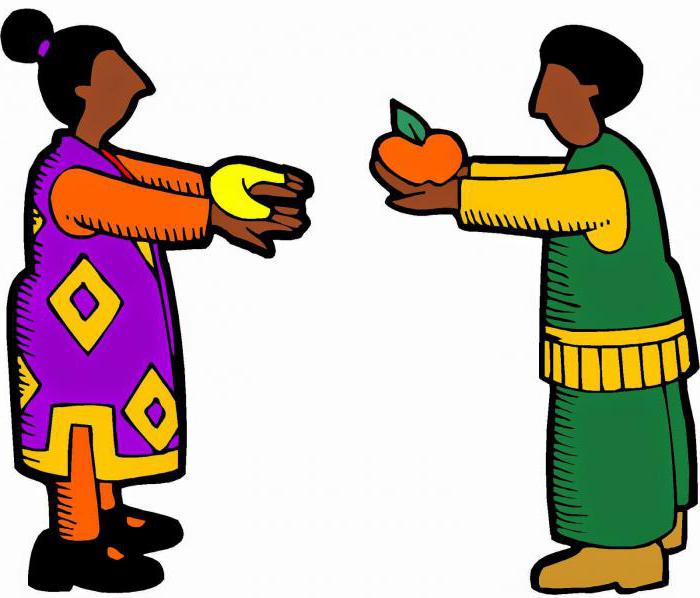In the famous cartoon "Three from Prostokvashino", the heroes, discussing where to get the money, come to the conclusion that you need to sell something unnecessary. Often, what is not needed by one person is urgently needed by another. The exchange of goods often solves the problem of an excess or shortage of resources, services and other things. And this is the first trade relationship between people, companies and countries.

Natural economy
Until the Filipinos introduced money into mass circulation as a universal way of mutual settlements, trade was conducted according to the “commodity-commodity” formula. What is barter in the classical sense? According to many definitions, barter is a contract for the exchange of goods and services without a cash flow. In this type of transaction, according to the agreement drawn up by the two parties, the goods (services) of the participants in the transaction are exchanged among themselves. In most cases, two parties are involved in a barter agreement, who decide to exchange goods.
Cash is the collateral value of the goods. In a standard barter transaction, the exchange of goods occurs at an estimated value, that is, the value of the goods in cash should be in equilibrium. But in carrying out operations of this kind, companies can rely on their own vision of the value of the exchange commodity.

Types of transactions
The barter transaction is divided into two types.
Closed. Two parties to the transaction enter into an agreement according to which each of them receives (gives) a strictly defined product (service). For example, a publisher receives a certain amount of paper from a print shop in exchange for placing a print shop advertisement on the pages of a newspaper publisher. This is an exchange of goods for a service.
The participants in the transaction undertake to provide a certain amount of tons of paper in exchange for advertising space in the newspaper for a strictly defined period of placement, for example, for a year. The principle of “goods - goods” is even simpler, for example, the exchange of a cubic meter of forest for the equivalent amount of nails. Once the exchange is completed, the transaction is considered completed. Contracts of this kind are concluded without prolongation. The same scheme can be used to barter services between organizations.
Open. Several parties can become participants in an open barter transaction. For example, by putting up several cubic meters of timber for barter exchange, a company can exchange parts in several organizations for spare parts for cars, nails, and carrier services.

Types of barter agreements
What is barter? This is a flexible system that helps organizations conduct trade and production activities without the use of foreign exchange transactions. You can negotiate netting through the exchange system in various ways.
Counter purchases are made between two business entities on the condition that one side instructs the other to sell the products and purchase the raw materials with the proceeds and deliver them to the first side.
Counter deliveries - a barter transaction in which the first side delivers the second equipment. The second netting supplies the first goods manufactured on equipment, or materials for the manufacture of equipment.
Barter rent - one of the parties to the contract provides the second with a room for rent, a means of production. The second party to the contractual relationship delivers the produced goods (services) against the cost of the lease. A variant of the relationship in a rental barter may be the repair work of the premises, equipment, etc.
Raw-product barter (tolling) - one of the parties to the agreement provides raw materials for the production of products, the second processes the raw materials and returns the finished products at net cost.

When are barter relationships needed?
What is barter for enterprises and organizations? This is a form of relationship where cash remains in circulation, but business processes do not suffer. The number of barter operations increases during a period of economic crisis, when enterprises need to maintain production cycles, but there is no cash inflow. In fact, enterprises and companies are switching over to offsetting relations, which allows them to carry out commodity operations without dependence on energy price spikes, exchange rates, and other indicators. In this case, crisis costs have little effect on commodity (raw) exchange. Barter is convenient for partner companies that have long-standing relationships. Thus, financial losses are minimized, especially in the multicurrency transaction system.
Cons of barter deals
Finding out what barter is, one cannot but mention the disadvantages of these agreements. The disadvantages include the complexity of mutual valuations of goods during the exchange, the goods are not valued at the most profitable cost. Nevertheless, in many situations, a barter transaction is much more attractive than monetary relations. For example, packing stocks of a company forces one to get rid of surpluses at a lower price, but if it is possible to exchange finished goods for raw materials, the company will greatly benefit.
